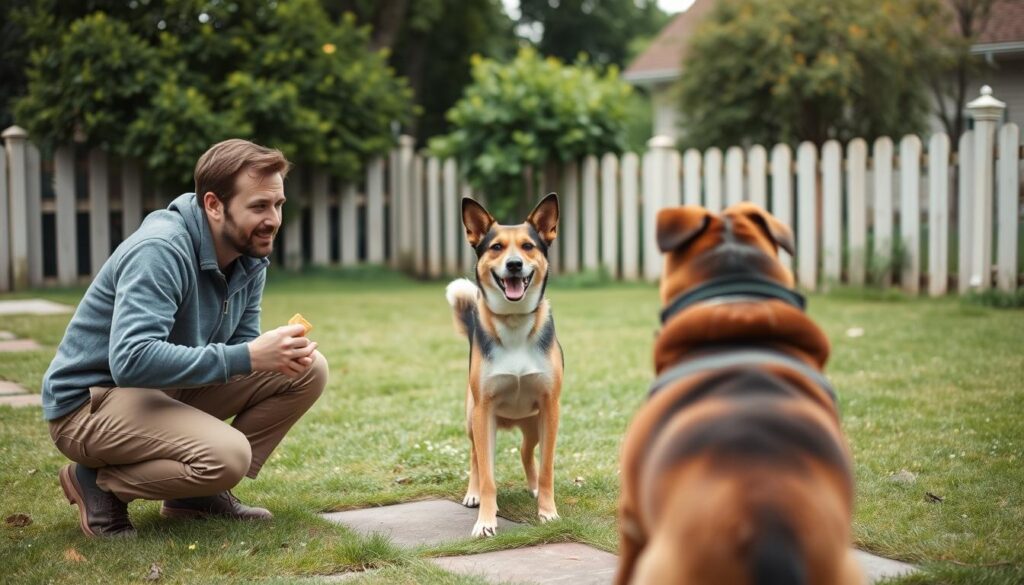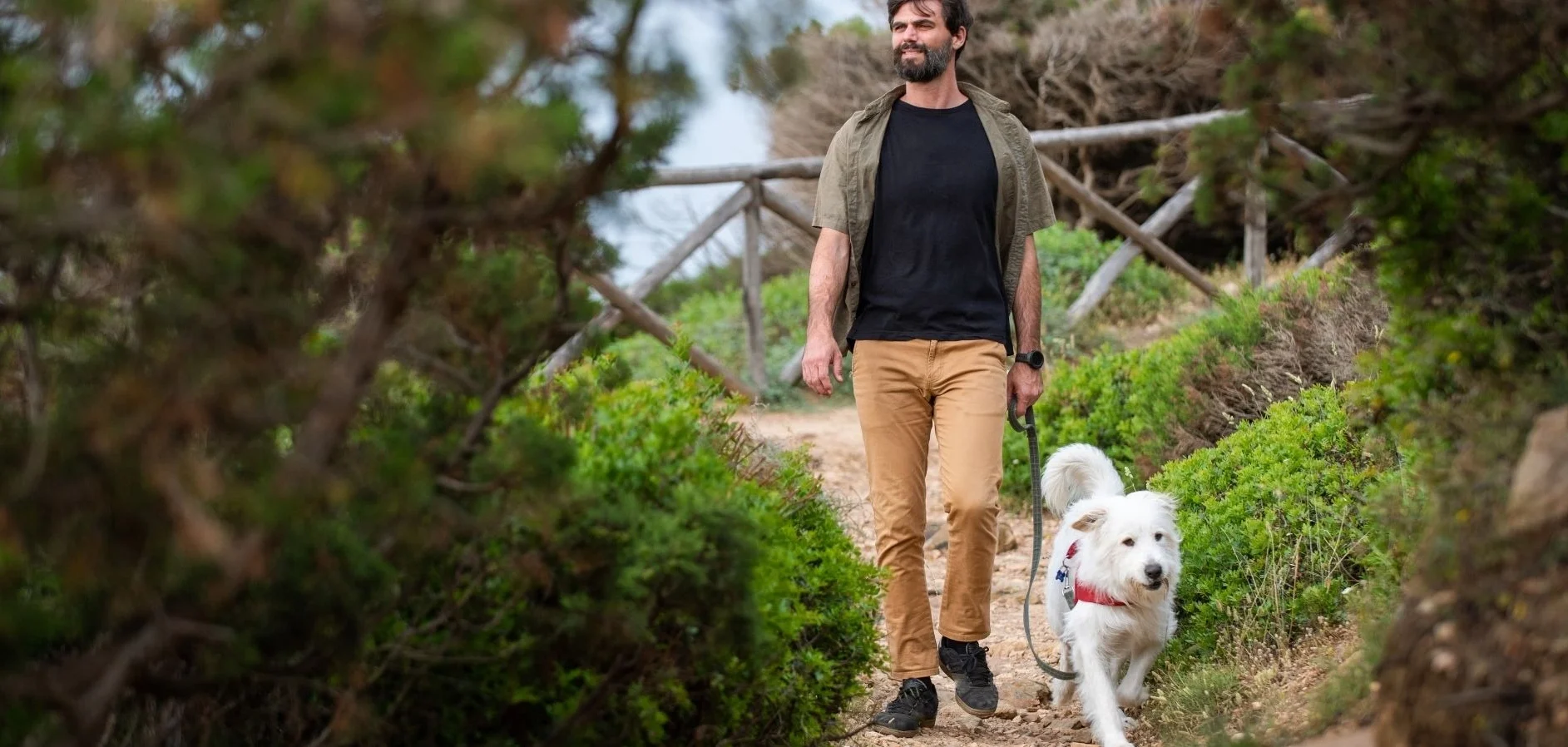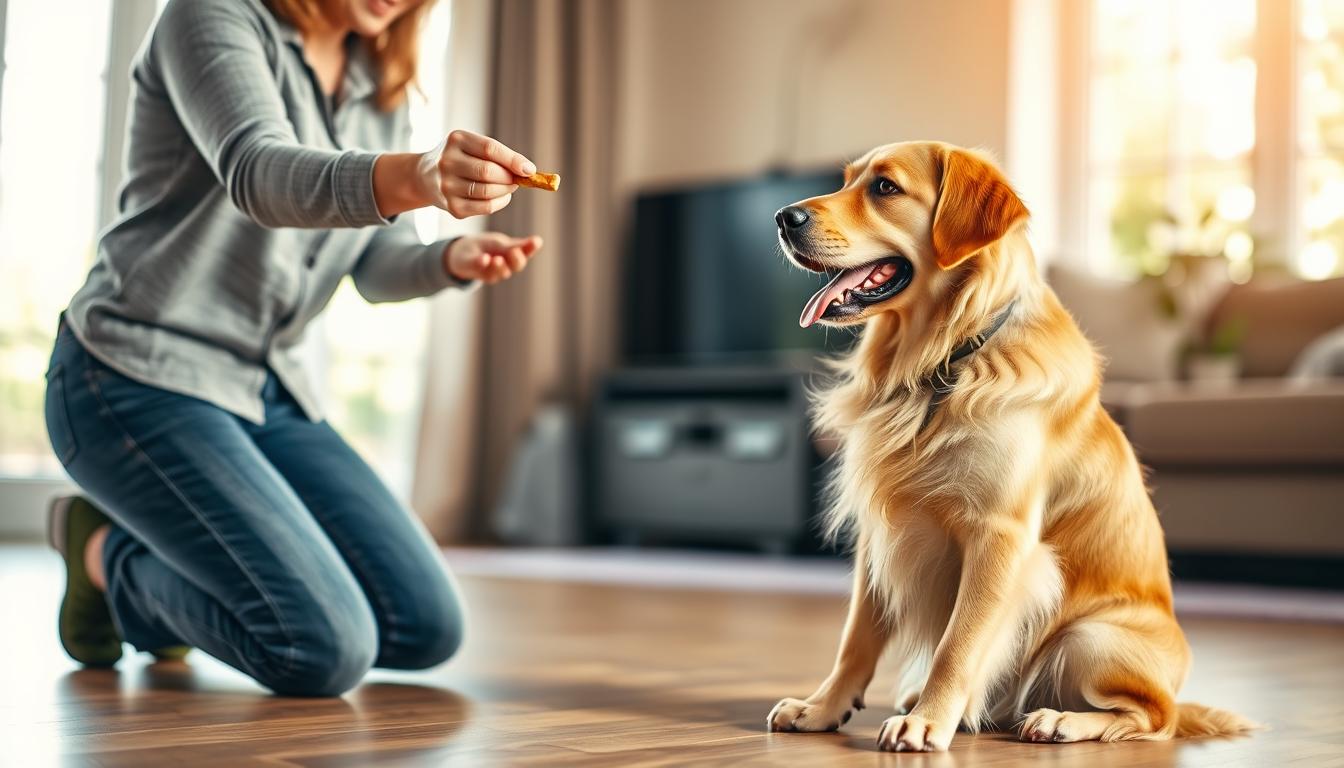How to Teach a Dog to Sit Quickly and Easily
Table of Contents
How to Teach a Dog to Sit is often the first joyful step in building a strong bond with your furry friend. Every dog owner remembers that special moment when their pet learns a new command. Teaching your dog to sit is more than just a trick — it’s a way to communicate, build trust, and understand each other better.
When I brought my rescue dog home, I felt overwhelmed by training. Learning the sit command was our first step together. It brought us closer, making our bond stronger.
Dog training needs patience, consistency, and understanding. The sit command is a basic skill that helps control your dog. It’s important for beginners or those looking to improve their training.
Key Takeaways
- The sit command is essential for basic dog communication
- Training builds trust between you and your dog
- Patience is key in successful dog training
- Consistent practice leads to better results
- Positive reinforcement works best for teaching commands
- Every dog can learn at their own pace
- Training strengthens the human-dog bond
Understanding the Importance of the Sit Command
c Teaching a puppy to sit is a key part of dog training. It helps you and your dog communicate better. This simple command is not just for control. It’s also a way to manage your dog’s behavior in different situations.
Training should start early and be consistent. The sit command is a great start for more complex training. It helps your puppy learn discipline and focus.
Benefits of Teaching Sit First
- Prevents jumping on people
- Creates immediate attention control
- Reduces potential aggressive behaviors
- Establishes basic communication patterns
When to Start Training
Experts say to start sit training at 8 weeks old. Puppies learn best at this age. Short, fun training sessions of 5-10 minutes keep them interested.
Setting Realistic Expectations
| Age Range | Expected Progress |
|---|---|
| 8-12 weeks | Basic command recognition |
| 3-6 months | Consistent sit on command |
| 6-12 months | Refined sit in various environments |
Remember, patience is crucial in teaching your dog to sit. Every puppy learns at their own pace. So, celebrate small wins and stay positive during training.
Essential Supplies for Training Success
Getting ready for positive reinforcement sit training needs careful planning and the right tools. To start a successful sit command for dogs, gather essential supplies. These will make your training smooth and fun.
Here are the key items you’ll need for effective dog training:
- High-value treats – Small, soft treats that your dog finds irresistible
- Quiet training space with minimal distractions
- 15-20 minutes of dedicated training time daily
- Comfortable clothing that allows free movement
- Patience and positive attitude
When picking treats for positive reinforcement sit training, look for:
- Bite-sized and easy to consume quickly
- Highly appealing to your dog
- Nutritionally appropriate
- Different from regular meals
Your enthusiasm is as important as the physical supplies. Dogs do best when their handler is calm, consistent, and excited about the sit command. Remember, every dog learns differently, so be ready to adjust your approach.
Pro tip: Keep training sessions short and fun to maintain your dog’s interest and motivation.
Creating the Perfect Training Environment
Starting your dog’s sit training right means setting up a great learning space. The right place can make your training much more effective. You want a calm, focused area where your dog can learn fast and feel sure of themselves.
To get your training off to a good start, consider a few important things. These will help you and your dog do well together.
Choosing the Right Location
Find a quiet spot in your home with few distractions. A room like the living room or a quiet corner of the kitchen is perfect for starting. The area should be:
- Familiar to your dog
- Free from loud noises
- Spacious enough for movement
- Comfortable temperature
Minimizing Distractions
It’s key to keep distractions away for good training. Turn off TVs, silence phones, and ask family to be quiet. Consistency and focus are your greatest allies in teaching your dog new commands.
Setting Up Your Training Space
Get your training area ready with what you need close by:
- Treats for positive reinforcement
- A comfortable mat or training area
- Water for your dog
- Leash (if needed)
Start with simple indoor training and then move to outdoor challenges. Begin with easy steps and add more as your dog gets better.
How to Teach a Dog to Sit
Teaching your dog to sit is a key part of dog obedience. With the right approach, your dog can learn this command fast. Use positive reinforcement and fun training methods to make learning enjoyable.
First, gather high-value treats to motivate your dog. Choose small, soft treats that can be eaten quickly. Your dog’s favorite snacks will keep them interested and eager to learn.
- Select treats that are small and easy to consume
- Use treats your dog finds especially delicious
- Keep training sessions short (5-10 minutes)
To start, follow these simple steps:
- Hold a treat close to your dog’s nose
- Slowly move the treat up and slightly back over their head
- As your dog’s head tilts back, their bottom will naturally lower
- The moment they sit, say “Sit” and immediately reward them
Consistency is key in sit training. Practice in different places and with distractions. Always use a clear voice and reward your dog right away when they sit.
“Patience and positive reinforcement are the keys to successful dog training.” – Professional Dog Trainer
With regular practice, your dog will learn to associate “Sit” with the action. This command will become a reliable part of their obedience.
Understanding Positive Reinforcement Techniques
Positive reinforcement is a great way to teach a dog to sit. It rewards your dog for good behavior, making learning fun. This method helps you bond with your dog and teach important commands.
Good dog training comes from knowing how dogs learn. It’s all about making training fun and rewarding for them.
Types of Rewards
Choosing the right rewards is key. Here are some popular ones:
- High-value treats
- Favorite toys
- Enthusiastic physical affection
- Short play sessions
Timing of Rewards
When you reward your dog is very important. You should:
- Reward right after they do what you want
- Keep the timing the same
- Be fast and accurate
- Avoid waiting too long to reward
Verbal Praise Methods
Verbal praise is also great. Use a consistent, upbeat tone when you praise your dog. Saying “good” or “yes” can help them learn the sit command better.
Remember, every dog is unique. Try different rewards to see what works best for your dog.
Common Mistakes to Avoid During Training

Learning the dog training sit command takes time and understanding. Many dog owners make mistakes that slow down training. It’s important to know these common errors to train successfully.
Avoid these key mistakes during your dog sit training sessions:
- Training for too long: Keep sessions short and engaging. Puppies and adult dogs have limited attention spans.
- Using negative reinforcement: Punishment can create anxiety and reduce learning effectiveness.
- Forcing your dog into a sitting position physically, which can cause stress and resistance
- Inconsistent command words or hand signals
- Skipping regular practice sessions
Effective dog sit training needs a positive, calm environment. Your dog learns best when training is fun, not stressful. Use treats, praise, and short training intervals to keep your dog motivated.
Professional dog trainers suggest breaking training into 5-10 minute sessions throughout the day. This keeps your dog interested and prevents mental fatigue.
“Training should be a bonding experience, not a battle of wills.” – Professional Dog Training Expert
Remember, each dog learns differently. Pay attention to your dog’s individual temperament and adjust your training strategy accordingly. Patience, consistency, and positive reinforcement are the keys to successful dog training.
Advancing Your Dog’s Sit Training
Once you’ve got the basic sit command down, it’s time to level up. Sit training is more than just a command. It’s about making your dog’s sit a strong, reliable skill for any situation.
Getting past the basic sit command takes patience and smart practice. You want to turn the sit command into a solid behavior in various situations.
Extending Sit Duration
Start by making your dog sit for longer. Begin with short times and then increase it:
- Start with 3-5 second sits
- Slowly increase to 10-15 seconds
- Practice sitting while you move around
Introducing Distance Challenges
Adding distance to the sit command makes it more reliable. Follow these steps:
- Begin with small steps away from your dog
- Gradually increase the distance
- Use a long leash for control
Training in Varied Environments
Practice the sit command in different places:
| Environment | Training Focus |
|---|---|
| Quiet indoor space | Reinforce basic skills |
| Backyard | Introduce mild distractions |
| Public park | Challenge with high distractions |
Remember, consistency is key in sit training for dogs. Each new environment is an opportunity to strengthen your dog’s skills.
Patience and positive reinforcement will help you and your dog succeed in advanced sit training techniques.
Troubleshooting Training Challenges

Teaching a puppy to sit can be tricky. Even with great techniques, you might hit roadblocks. These challenges can test your patience and skills.
Some common issues dog owners face include:
- Puppy refusing to sit on command
- Dog only sitting when treats are visible
- Breaking the sit position too quickly
- Inconsistent response to training
When your puppy struggles, finding the cause is key. Motivation and consistency are crucial. Check your treats and training area. Are you using high-value treats? Is the area free from distractions?
Effective sit training techniques include:
- Reset expectations and be patient
- Vary your reward types
- Practice in short, engaging sessions
- Use clear, consistent verbal commands
If your dog seems disinterested, try new approaches. Some puppies like play-based rewards or different treats. Remember, each dog learns in their own way.
“Persistence and positive reinforcement are your best tools in overcoming training challenges.” – Professional Dog Trainer
Make training fun, short, and stress-free. Your excitement and patience will help your puppy learn the sit command.
Conclusion
Teaching your dog to sit is more than a simple trick. It’s about building a strong bond with your pet. By following a step-by-step guide, you’ll grow closer and learn important communication skills.
Patience and dedication are key in this journey. Every practice session brings you closer to a well-behaved dog. Remember, every dog learns at their own pace, so stay positive and keep trying.
The sit command is just the beginning. It opens the door to more advanced training and helps manage your dog’s behavior. By starting early, you lay the foundation for a lifelong friendship with your dog.
Make training sessions short, fun, and rewarding. Celebrate small wins and stay focused on your goal. With time and effort, your dog will learn the sit command and grow closer to you.
FAQ
At what age should I start teaching my dog to sit?
You can start teaching your dog to sit at 8 weeks old. Puppies can learn basic commands early. Early training helps build good habits and a strong foundation for future training.
How long does it typically take to teach a dog to sit?
The time it takes varies by dog’s age, breed, and learning pace. Most dogs learn the sit command in a few days to two weeks. Short, daily training sessions of 5-10 minutes work best.
What treats work best for sit training?
Use small, soft, high-value treats that your dog loves. Small pieces of chicken, cheese, or commercial training treats are great. They should be small to not interrupt the training.
My dog won’t sit for more than a second. What should I do?
Practice in a quiet place with few distractions. Use a treat lure and reward your dog for longer sits. Be patient and consistent in your training.
Can older dogs learn to sit?
Yes, dogs can learn new commands at any age. Older dogs might take longer, but they can still learn with patience and positive reinforcement.
How do I prevent my dog from sitting only when treats are visible?
Use a variable reward system to phase out visible treats. Reward with treats, praise, or play sometimes. Use treats from different locations and eventually hide them.
Should I use a verbal cue or hand signal when teaching sit?
Use both a verbal cue (“sit”) and a hand signal together. This helps dogs understand the command better, especially in noisy places or for dogs with hearing issues.
What if my dog seems uninterested in training?
Keep training sessions short, fun, and when your dog is alert. Use high-value treats and end on a positive note. If your dog is disengaged, try different times or approaches.
How often should I practice the sit command?
Practice 3-5 times a day for 5-10 minutes each. Short, frequent sessions are more effective than long, infrequent ones.
Can I teach my dog to sit if they have never been trained before?
Yes, you can teach sit to dogs of any age, even without previous training. Start with basic techniques, use positive reinforcement, and be patient. Consistency and positive rewards are key.
There are no reviews yet. Be the first one to write one.


